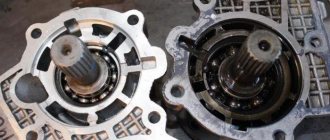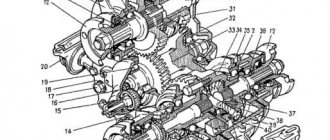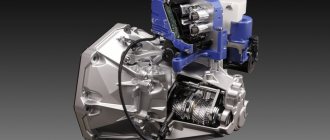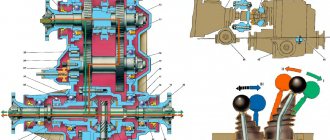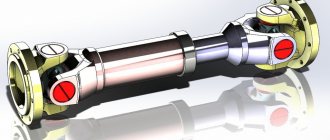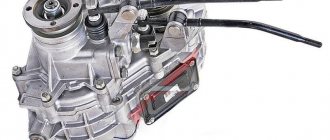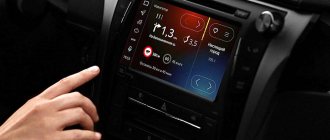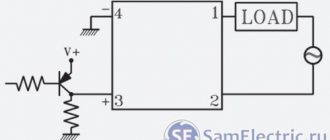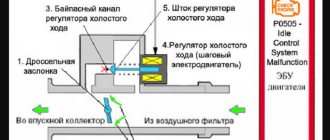A transfer case (transfer case) is a component of an all-wheel drive vehicle that increases engine torque and distributes it between the drive axles. This allows you to fully realize the capabilities of all-wheel drive on asphalt, slippery surfaces and off-road. On special equipment, the transfer case can transmit torque to a winch, crane or other equipment. The transfer case also performs the following functions:
- an increase in torque required to overcome the rolling resistance of the drive wheels when driving off-road;
- ensuring vehicle stability in slow motion while achieving maximum torque.
Transfer case device
Transfer case design
The general design of transfer cases has the following layout.
- Main drive shaft.
- Drive shafts for front and rear axles.
- The transmission is chain or gear.
- Center differential and locking mechanism.
- Downshift or synchronizer.
Structurally, the transfer case consists of a two-part housing filled with oil, in which the engine drive shaft is connected through a chain (or gear) transmission to a center differential and a locking device, connected to two drive shafts of the front and rear axles.
Video about how the transfer case works
Types of transfer cases
Among the mass of modifications, we can distinguish the main types of transfer cases:
1. According to the location of the drive shafts of the drive axles
- with coaxial shafts (the drive shaft from the gearbox is coaxial with the rear axle drive shaft). This type is widespread due to its simple design.
- with misaligned shafts (the gearbox drive shaft is not aligned with the rear axle drive shaft). This type is characterized by high efficiency, compact dimensions, and from the point of view of acoustic parameters (not the least important parameters) it looks much more attractive than its counterparts.
2. By driving axles
- with a drive axle drive blocking mechanism. This type allows you to use the maximum traction force of the car without slipping the wheels. But this type has some disadvantages - an increase in fuel consumption by the car, increased tire wear and an increase in load on transmission elements.
- with differential drive. This type of gearbox is distinguished by the presence of a center differential, which makes it possible to rotate the drive shafts at different speeds. The downside is a decrease in the vehicle's cross-country ability. To increase traction characteristics, center differentials are manufactured with a forced locking element.
3. Based on the number of gears, there are one, two and three-speed gearboxes. Transfer cases with two-stage transmission are more popular.
Design
The transfer case design of the simplest design includes only a few components:
- drive shaft (it is the secondary shaft of the gearbox);
- driven (rotation is transmitted through it to the rear axle);
- intermediate shaft;
- front axle drive shaft;
- control mechanism (not always present);
- frame.
In a simple box, the interaction between the shafts occurs thanks to gears.
Transfer case for BMW xDrive cars
Later, another element was added to the design - a differential, which was called an interaxle differential (also known as an interaxle differential).
Note that this is only one type of transfer case design; cars use different types of transfer cases according to their design, so there is even a small classification of them according to a number of characteristics.
Center differential
This unit allows you to distribute the interaxle torque and allows the drive shafts to rotate at different angular speeds. This is especially important when cornering as the wheels travel different distances and therefore must rotate at different speeds. If the transfer case is not equipped with such a unit, the wheels can only be rotated at different speeds by disabling one axle.
Center differentials can be symmetrical or asymmetrical. The first works in such a way that the torque is distributed equally to both axles, the second divides it in a certain proportion.
Center differential locking mechanism
In order for the car to fully realize its off-road capabilities, the center differential is equipped with a locking mechanism, the purpose of which is to force the wheels of both axles to rotate at the same speed. Blocking can occur either forcefully or manually, depending on the type of mechanism. The following types of locks are currently used:
- self-locking differential Torsen;
- friction multi-plate clutch;
- viscous coupling (viscous coupling).
The transfer case of crossovers is equipped with the first two mechanisms due to the disadvantages described below.
Viscous coupling
The viscous coupling is built on the basis of a special fluid, which is located between numerous transfer plates that rotate relative to each other with small gaps. The plates are connected to the output shafts, and when the difference between the rotations of the plates becomes very large (one of the axes is slipping), the liquid sharply increases its viscosity and binds (rigidly glues) the plates together, blocking the differential.
But it cannot remain in this state for a long time because the liquid overheats and loses its properties.
Differential Thorsen
This differential is created on the basis of worm gears and its main ability is to quickly and accurately redistribute torque between the axles. A very good mechanical design based on worm gears, but its main drawback is unreliability, that is, in critical situations it is prone to rapid destruction.
Multi-plate clutch
This is a more reliable mechanism, which all modern crossovers are switching to.
Its device is a set of disks that rub against each other depending on the force that presses on them. And the greater the force, the stronger they block the differential.
The clamp is controlled by a computer based on readings from sensors and the position of the selector.
It should be said that the two previous systems did not require driver participation and worked independently.
The multi-plate clutch also begins to overheat during prolonged slipping, and in order to preserve the mechanism, the electronics turns off its operation, and the car becomes single-wheel drive. This is a wise decision for “delicate” SUVs, which are sometimes unknowingly tested for off-road use, preserving them from damage.
Another important factor in crossovers is the absence of a low range in the transmission.
As for SUVs, it is worth noting the highest reliability of their transmission when driving off-road. The locking in them is carried out rigidly, without the possibility of smoothly changing the torque between the axles.
Yes, this has a bad effect on control at high speeds, but you can skid as much as you like without fear of overheating.
In addition, in the transfer case of such cars there is a range of multipliers for engaging a lower gear. There may be one or two reduced modes.
Thanks to this, SUVs can climb very steep mountains or drive through mud without fear of not having enough engine traction.
Also, a lower gear makes it possible to move at very low speeds (1-2 km/h), which gives the driver time to more accurately choose the trajectory without stopping the car.
To summarize, you can see that the transfer case is a very useful unit. And if you don’t abuse it in vain, but take into account the purpose of the vehicle, its service life will be very long.
Drive type and the influence of the transfer case on it
The operating features of the transfer case affect the type of all-wheel drive, of which there are only three:
- Constant full.
- All-wheel drive, manually activated.
- Automatic drive.
An example of permanent all-wheel drive is a transfer case with a conventional differential equipped with a lock (common name - Full Time). In cars with such a system, the transfer case provides constant rotation transmission along two axes.
A manually connected drive is called Part Time. In a car with such a drive system, the transfer case in normal driving mode supplies rotation to only one axis, while the second is activated when necessary. In such units, a differential is not used, but instead, clutches are installed - mechanical, electromagnetic, which connect/disconnect the second axle.
A system that uses both bridges in automatic mode is OnDemand. It is used on passenger cars, and in this case the transfer case is aimed at increasing cross-country ability and improving handling. The control is carried out by electronics interacting with the ABS. In such transfer cases there is no differential, but instead an electrically driven clutch is installed. In the OnDemand system, the transfer case by default only applies rotation to one axle. But when certain driving conditions arise, the electronics engage the clutch drive and the second axle is connected.
Chain transmission
To redistribute the torque, a chain was created in the transfer case. Thanks to the mutual action of the chain and 2 wheels with teeth, chain transmission occurs. Sometimes there are periods when it is necessary to use a gear drive to replace a chain drive. Comparing these two gears, the gear one is the most reliable.
This is how the distribution box got its name
The box inherited its name due to its close connection with the gearbox. At low vehicle speeds, torque is distributed because the gearbox has both a reduction gear and a range multiplier.
Therefore, vehicles can travel in difficult conditions, without the presence of a road surface. The range-multiplier helps reduce the speed of rotation of the shafts, as a result of which the large torque does not disappear. Thanks to the reduction series, vehicles can have a certain number of gears. In emergency situations, the motorist will have more chances to calculate the required gear ratio. This kind of equipment prolongs the performance of the gearbox, while saving the car owner’s costs.
Do you need a transfer case?
Like any mechanism, the Republic of Kazakhstan has its advantages and disadvantages.
Let's start, perhaps, with the cons. More precisely, from one but significant disadvantage of the transfer case. The fact is that most of its parts are quite expensive. Therefore, replacing them will not be cheap. And those parts that are sold at reasonable prices are difficult to repair, so they may also require funds from the car owner for the work of a repairman.
Now the pros:
- When the transfer case operates while the car is moving at low speed, torque is transmitted to the axles. This increases the cross-country ability of the SUV.
- It is noteworthy that when the transfer case is operating, large torque cannot be lost. This is achieved thanks to a demultiplier. He is the machine's assistant in reducing the intensity of torsion of the drive shafts.
- Also, the driver of a car equipped with a transfer case has the opportunity to independently determine the gear number.
- When driving in difficult conditions, the RK will become a friend and assistant to the motorist, helping his “iron horse” to effectively overcome landscape obstacles.
- And, of course, one of the leading advantages is that the operation of the transfer case extends the life of the transmission.
Purpose
The purpose of the transfer case (TC) is to distribute the transmitting force between the drive and additional axles. The transfer case also allows you to turn the drive axle on or off and, in some cases, reduce or increase the gear ratio and thereby double the number of existing gears used for the vehicle’s gearbox.
All-wheel drive diagram with transfer gearbox
” data-image-description=”” data-image-title=”where is the dispenser” aperture?:?0?,?credit?:??,?camera?:??,?caption?:??,?created_timestamp ?:?0?,?copyright?:??,?focal_length?:?0?,?iso?:?0?,?shutter_speed?:?0?,?title?:??,?orientation?:?0 ?}?=”” data-image-meta=”{” data-comments-opened=”1″ data-orig-size=”900,559″ data-orig-file=”https://i0.wp.com/ vaznetaz.ru/wp-content/uploads/2019/09/where-is-razdatka.jpg?fit=900%2C559&ssl=1″ data-permalink=”https://vaznetaz.ru/razdatochnaya-korobka/attachment/gde -naxoditsya-razdatka” data-attachment-id=”9899″ itemprop=”url image” sizes=”(max-width: 700px) 100vw, 700px”>
Such driving is especially important when driving on a good highway; the transfer gearbox allows you to disable the additional axle, thereby relieving the load on the engine and reducing fuel consumption for the transmission. The creation of a transfer case dates back to the beginning of the twentieth century, when car racing on highways and off-road conditions began to develop. The use of such a unit is especially necessary for trucks where it was planned to use an additional axle axle. It was necessary to somehow balance the torque between the two axles.
As soon as the car gets into off-road conditions, the use of a transfer case together with a center differential helps the engine distribute rotating torque to the axles in the required proportion to the weight of the load, ensuring that the wheels of different axles rotate evenly at the same speed, thereby reducing the load in the transmission and reducing the wear of mechanisms, and most importantly, the car overcomes obstacles and moves smoothly in bad road conditions.
Transfer case control
Transfer case control
Old SUVs, trucks and special vehicles usually have manual (mechanical) control of the transfer case. To connect or disconnect one of the axles, as well as to engage the differential or low range, a lever is used, usually located in the cabin floor next to the gearshift lever. To turn it on, the car sometimes needs to come to a complete stop.
Newer models have manual electrical control : all operating modes of the transfer case are selected using buttons on the dashboard. If there is a synchronizer in the transfer case, then stopping the car will not be necessary.
Modern cars use automatic transfer case control. When selecting the automatic mode, the on-board computer itself determines the slipping of the axles, after which it redirects the torque. If necessary, turns on the differential lock. The driver can turn off the automation and do all the work on the go independently. There is no control lever.
All types of crossovers and all-terrain station wagons have fully automated transfer case control mechanism. The driver cannot control the mechanism himself, since all decisions are made electronically.
Operating modes
The transfer case can be controlled using a special lever or buttons (rotary device) on the dashboard. On vehicles with all-wheel drive that are not designed for difficult road conditions, the transfer case operates in automatic mode.
Depending on the design features, the transfer case has several operating modes.
- Only the rear axle is active.
- The front and rear axles work. This type of drive is implemented in Niva.
- The front and rear axles work, the differential is locked. This mode provides maximum maneuverability.
- Transfer case with reduction gear. Both axles are working, the differential is locked, and the reduction gear is active.
- The front and rear axles work, the differential locks in automatic mode.
If all-wheel drive is connected, then the following switchable modes can work here:
- 4L – drive on both axles in low gear.
- 4H – torque is supplied to both axles.
- 2H – torque is transmitted to only one (drive) axle.
In this case, it is allowed to switch between 2L and 4H modes while the vehicle is moving only if there is no slipping of the drive wheels. But switching between modes 4L and 4H while driving will not work due to a design feature.
If all-wheel drive is permanent, then there are the following modes:
- 4L LOCK – all-wheel drive, differential lock on, low gear.
- 4H LOCK – four-wheel drive, center differential locking, direct transmission.
- 4H AWD – four-wheel drive, differential lock disabled, direct transmission.
Depending on the design, you can switch the 4H LOCK and 4H AWD modes both while the vehicle is stationary (without wheel slipping) and while driving.
Main malfunctions of transfer cases and their causes
The transfer case is a mechanical device, which, like other mechanisms, can have a certain service life, where some malfunctions occur during operation. There are several factors that influence the lifespan of a relay.
- Design.
- All-wheel drive device.
- Operating mode.
- Maintenance within specified periods.
Commonly encountered major faults include the following.
- Knocking, humming, howling are the consequences of wear of gears and bearings.
- Strong vibration in the transfer case. It can occur especially during movement due to wear of the bearings.
- Leaking or leaking oil. Usually due to a violation of the tightness of the seals or due to other violations of the tightness of the joints in the housing.
- Difficulty in turning on or spontaneous shutdown of the box - wear of the gear teeth or clutch, incorrect adjustment.
- Defect of gears, couplings, clamps. Requires repair, disassembly of the box, replacement of worn parts.
- Stretching of the box chain due to wear.
- When moving, there are jerks, malfunctions in the operation of the gearbox, and strong stretching of the chain.
- Overheating or rapid heating of the clutch with the smell of burning oil, rubber and wear of the servo drive, friction clutch.
- Instability of work occurs under loads and turns.
- The electronic control does not work due to the failure of the electromagnet, there is no power circuit, or the wiring is damaged.
Video on the topic
Sources
- https://AvtoTachki.com/chto-takoe-razdatochnaya-korobka-i-dlya-chego-nuzhna/
- https://VazNeTaz.ru/razdatochnaya-korobka
- https://principraboty.ru/razdatka-razdatochnaya-korobka-chto-yeto-takoe-i-kak-rabotaet-razdatochnaya-korobka/
- https://CarExtra.ru/obzory/razdatochnaya-korobka-ustroystvo-printsip-rabotyi.html
- https://ZnanieAvto.ru/uzly/razdatochnaya-korobka.html
- https://Shinomontazh-Penza.ru/transmissiya/dlya-chego-nuzhna-razdatka.html
- https://auto-ru.ru/razdatochnaya-korobka-chto-eto.html
- https://avtomotoprof.ru/obsluzhivanie-i-uhod-za-avtomobilem/razdatochnaya-korobka/
- https://AvtoNov.com/%D1%80%D0%B0%D0%B7%D0%B4%D0%B0%D1%82%D0%BE%D1%87%D0%BD%D0%B0%D1 %8F-%D0%BA%D0%BE%D1%80%D0%BE%D0%B1%D0%BA%D0%B0-%D1%87%D1%82%D0%BE-%D1%8D% D1%82%D0%BE-%D1%82%D0%B0%D0%BA%D0%BE%D0%B5/
- https://TechAutoPort.ru/transmissiya/sistemy-polnogo-privoda/razdatochnaya-korobka.html
